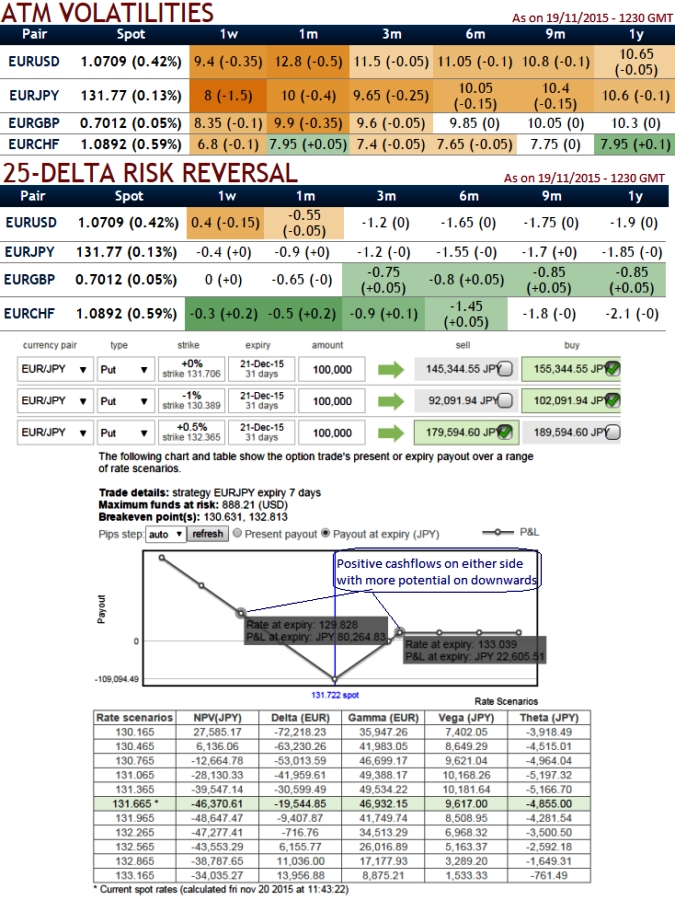Please be informed that how delta risk reversal numbers are getting higher negative values gradually in a long run (flashing at -1.85 for 1 year expiries).
Simultaneously, observe IV factor also for ATM contracts with all expiries. It is jumping up from 8 to 10% for 1 month maturities.
Option writers are on competitive advantage.
Hedging activities of downside risks are mounting up, as a result Put options seem costlier.
Volatility smiles most frequently tells that traders are willing to pay higher implied volatility prices as the strike price grows aggressively out of the money.
The challenge now is determining which strikes you should use in this strategy.
The broader the strike difference between short and long puts, the fewer puts you need to sell to cover the price of the long puts.
But at the same time, the coverage of long-to-short is going to be more difficult in the event of assignment.
The current spot FX is trading at 131.708 and it has been moving as per our previous technical assessment, we will continue to remain bearish with near targets extending dips up to 131.035 levels.
So, the recommendation for now is to add an extra long on put with 1M expiry any debit put spreads.
Strategy goes this way, Long 1M ATM -0.49 delta put and add one more long on 1M (1%) OTM -0.35 delta put, simultaneously short 1 lot of 3D (0.5%) ITM puts with positive theta values.
With these narrow strike differences, the profit potential is greater, so that the ratio needed is also lower to profit on underlying movement.
Caution: If you think the pair is going to crash, you should be loading up on put buys in existing strategy. The total cost of the trade is going to be the difference between the prices of the two options. (Compare total cost with strips which involves 3 long sides whereas backspreads have 2 but then caps both directions when IV is increasing).
FxWirePro: EUR/JPY ATM puts seem costlier - buy risk reversal preferring PRBS i/o option strips

Friday, November 20, 2015 6:22 AM UTC
Editor's Picks
- Market Data
Most Popular



 FxWirePro: USD/ CAD sustains gains as uptrend remains strong
FxWirePro: USD/ CAD sustains gains as uptrend remains strong  FxWirePro-Major crypto levels and bias summary
FxWirePro-Major crypto levels and bias summary  Major European Indices
Major European Indices  FxWirePro- Major US Indices
FxWirePro- Major US Indices  FxWirePro: GBP/USD gaining momentum for a move towards 1.3100 level
FxWirePro: GBP/USD gaining momentum for a move towards 1.3100 level  FxWirePro: USD/CAD retreats slightly but trend is still bullish
FxWirePro: USD/CAD retreats slightly but trend is still bullish  FxWirePro: GBP/AUD reverses recent rally, bias back to downside
FxWirePro: GBP/AUD reverses recent rally, bias back to downside  FxWirePro: USD/ CNY hovers near three-month, bias is bullish
FxWirePro: USD/ CNY hovers near three-month, bias is bullish  FxWirePro: NZD/USD downside pressure builds, key support level in focus
FxWirePro: NZD/USD downside pressure builds, key support level in focus  GBP/JPY in Focus: Watch for a Potential Reversal as Yen Strengthens!
GBP/JPY in Focus: Watch for a Potential Reversal as Yen Strengthens!  FxWirePro: GBP/AUD bullish outlook with scope to target 1.9900
FxWirePro: GBP/AUD bullish outlook with scope to target 1.9900  Dovish SNB Chairman Signals Flexibility: Bullish Outlook for Currency Pair!
Dovish SNB Chairman Signals Flexibility: Bullish Outlook for Currency Pair!  Bearish Engulfing Pattern Signals Caution for BNB/USD: Key Levels to Watch!
Bearish Engulfing Pattern Signals Caution for BNB/USD: Key Levels to Watch!  EUR/USD Update: Cautious Optimism as Economic Data Sparks Trading Potential!
EUR/USD Update: Cautious Optimism as Economic Data Sparks Trading Potential!  FxWirePro- Major Pair levels and bias summary
FxWirePro- Major Pair levels and bias summary  FxWirePro: GBP/USD attracts buying interest, 38.2% fibonacci eyed
FxWirePro: GBP/USD attracts buying interest, 38.2% fibonacci eyed 































